Dive into the wild with me as we explore the intriguing face-off “wildcat vs hyena” and uncover nature’s secrets in an exciting contest! Nature has a way of surprising us, revealing the untold stories and fierce battles that unfold in the animal kingdom. In this article, we will delve into the captivating rivalry between these two formidable creatures, the wildcat and the hyena. Get ready to witness the clash of predators and discover the hidden mysteries of the wilderness.
- The wildcat vs hyena face-off is a captivating contest that unravels intriguing aspects of nature’s secrets.
- Wildcats, such as leopards and lynx, are agile predators that hunt alone, while hyenas are versatile scavengers known for their powerful bite.
- Hyenas live in packs and are known to scavenge on carrion, while wildcats rely on their hunting skills.
- The clash between wildcats and hyenas highlights their differences in hunting strategies, with hyenas’ pack hunting nature contrasting the wildcat’s solitary hunting habits.
- Both hyenas and wildcats play significant roles as apex predators in their respective habitats, contributing to the balance of the ecosystem.
Exploring the Wildcat and Hyena Rivalry
The wildcat and hyena rivalry is a fascinating subject, with hyenas often coming into conflict with various species of wildcats, including lions and other big cats. These encounters highlight the dynamic interactions between two powerful predators in the wild.
Hyenas, belonging to the family Hyaenidae, are known for their scavenging behavior and their ability to hunt in packs. They possess strong jaws and a powerful bite, which allows them to compete with other predators for food resources. In contrast, wildcats, classified under the family Felidae, are agile and solitary hunters. Species like leopards, panthers, and lynxes are known for their stealth and precision in hunting.
While hyenas rely on the strength of their pack to take down larger prey, wildcats rely on their speed and agility to hunt alone. This fundamental difference in hunting strategies sets the stage for intriguing face-offs between these two formidable creatures.
Quotes:
“The wildcat and hyena rivalry is an ongoing battle for dominance in the animal kingdom,” says wildlife expert Dr. Samantha Watson. “It’s a clash between the relentless scavengers and the skilled hunters.”
| Hyenas | Wildcats |
|---|---|
| Belong to the family Hyaenidae | Belong to the family Felidae |
| Scavengers, often known for their ability to steal kills | Agile hunters, relying on stealth and speed |
| Hunt in packs, displaying social behavior | Hunt alone, showcasing solitary behavior |
| Have a powerful bite force, allowing them to compete with other predators | Are known for their speed and agility, making them successful hunters |
The rivalry between hyenas and wildcats is an integral part of nature’s delicate balance. It showcases the diverse strategies employed by predators in their quest for survival. As we delve deeper into this intriguing wilderness face-off, we will uncover the unique characteristics and behaviors that define these remarkable creatures.
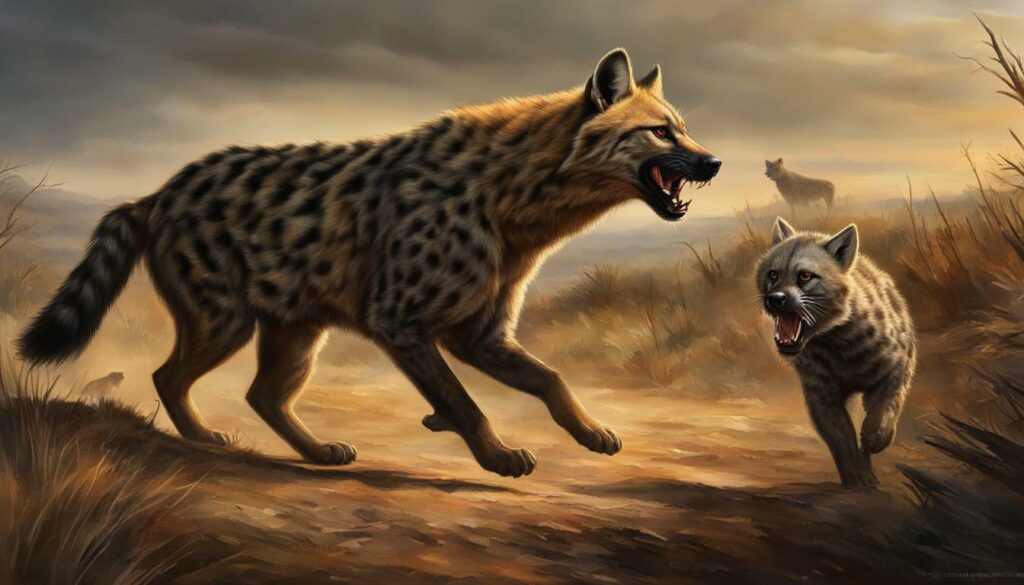
Stay tuned as we navigate through the wilderness, exploring the secrets of hyenas and wildcats, two apex predators engaged in an eternal dance of power and survival.
Understanding Hyenas: The Versatile Scavengers
Hyenas, particularly the spotted hyena, are fascinating creatures known for their scavenging abilities and powerful bite. These creatures thrive in various habitats, including woodlands, savannahs, and grasslands, making them adaptable predators. Hyenas are opportunistic eaters and are known to scavenge on carrion, which provides them with a vital food source. This scavenging behavior has earned them a reputation as nature’s cleanup crew.
With their keen sense of smell, hyenas can locate carcasses from miles away, allowing them to capitalize on food opportunities. Their powerful jaws and bone-crushing bite enable them to break through the toughest hides and devour even the largest of prey. Hyenas have been known to bring down a wide range of animals, including wildebeests, zebras, and even young elephants, showcasing their incredible hunting prowess.
Spotted Hyenas: Masters of Adaptation
The spotted hyena, in particular, is a highly social and intelligent creature. Living in large clans, they work together to bring down larger prey and protect their territory. This coordination allows them to take on formidable opponents, such as lions, in intense battles for food and resources. Hyenas typically exhibit submissive behavior when confronted by lions, but they can hold their ground when necessary.
Despite their scavenging tendencies, hyenas are also skilled hunters and can successfully hunt and kill their own prey. Their adaptability and resourcefulness have helped them survive in diverse ecosystems. In the wild, hyenas play a vital role in maintaining the balance of nature, acting as both predator and scavenger.
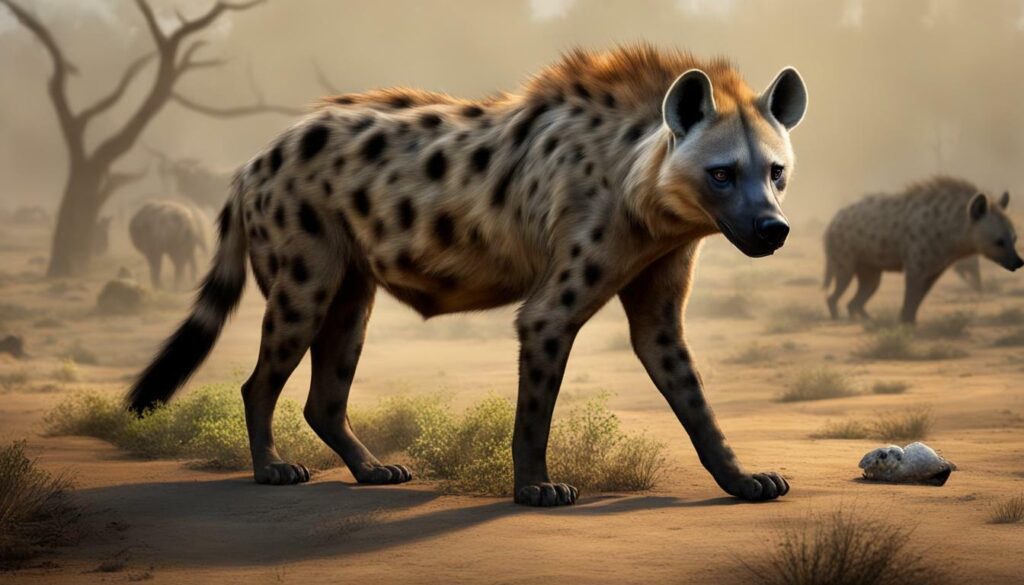
Hyenas are known for their powerful bite, capable of exerting immense force. Their bite force is one of the strongest among land-dwelling mammals, allowing them to crush bones and access the nutritious marrow within. This incredible bite strength makes hyenas formidable hunters and scavengers, capable of overpowering larger predators and dominating their food sources.
As versatile scavengers and skilled hunters, hyenas play a crucial role in maintaining the delicate balance of nature. Despite their reputation, they are not solely scavengers and have proven their ability to thrive as apex predators in the wild. Their adaptability, intelligence, and powerful bite make them a force to be reckoned with in the wilderness.
| Hyenas | |
|---|---|
| Known for | Scavenging abilities and powerful bite |
| Preferred habitats | Woodlands, savannahs, grasslands |
| Primary food source | Carrion and live prey |
| Social behavior | Live in large clans, work together to bring down prey |
| Bite strength | One of the strongest among land-dwelling mammals |
Wildcats: Agile Predators in the Wild
Wildcats, such as leopards, panthers, lynx, pumas, and ocelots, are agile predators known for their solitary hunting habits. These majestic creatures possess an unparalleled combination of stealth, speed, and strength, making them formidable hunters in the wild.
Leopards, with their distinctive spots and powerful build, are renowned for their ability to stalk their prey with remarkable precision. They rely on their acute senses and camouflage to launch surprise attacks on unsuspecting animals such as antelopes and monkeys. Panthers, on the other hand, prefer the cover of darkness, using their jet-black fur to their advantage as they silently maneuver through the shadows. Their exceptional climbing skills enable them to ambush prey from treetops, making them highly successful hunters.
Lynx, with their tufted ears and thick fur, are specialized predators adapted to cold climates. They excel in pursuing snowshoe hares and other small mammals, using their powerful hind legs to pounce on their prey. Pumas, also known as mountain lions, are renowned for their remarkable jumping ability, allowing them to leap upon their unsuspecting prey with astonishing speed and accuracy. Ocelots, with their distinctive spotted coat, are skilled tree climbers. They use their agility to snatch birds and small mammals from the branches above.
These wildcats share a common trait – they prefer to hunt alone. This solitary nature allows them to surprise their prey and ensures that they can fully enjoy the spoils of their hunt. By relying solely on their own abilities, wildcats have honed their skills to become some of nature’s most efficient and successful predators in the animal kingdom.

The table below provides a quick glimpse into the unique features and hunting techniques of these agile predators:
| Wildcat | Habitat | Prey | Hunting Technique |
|---|---|---|---|
| Leopard | Various habitats including forests, grasslands, and mountains | Antelopes, monkeys, and other small to medium-sized mammals | Stalking and ambushing |
| Panther | Diverse habitats across the world, including jungles and swamps | Deer, wild boars, and other large mammals | Nocturnal hunting and stealthy attacks |
| Lynx | Northern regions, including forests and mountains | Snowshoe hares and small mammals | Pouncing on prey from a concealed position |
| Puma | Western hemisphere, including mountains, forests, and deserts | Deer, elk, and other large mammals | Ambushing and chasing down prey |
| Ocelot | Tropical rainforests and thorn scrub habitats | Birds, rodents, and small mammals | Climbing trees and leaping from branches |
The Clash: Wildcat vs Hyena
The clash between wildcats and hyenas is an intriguing encounter, as these two creatures have distinct hunting strategies – hyenas hunt in packs, while wildcats prefer to hunt alone. Hyenas are known for their pack hunting nature, allowing them to take down larger prey by overwhelming it with their numbers. Their powerful bite force and ability to work together make them formidable predators in their own right. On the other hand, wildcats rely on their agility and stealth to successfully hunt their prey. They are solitary hunters, using their speed and cunning to sneak up on their targets.
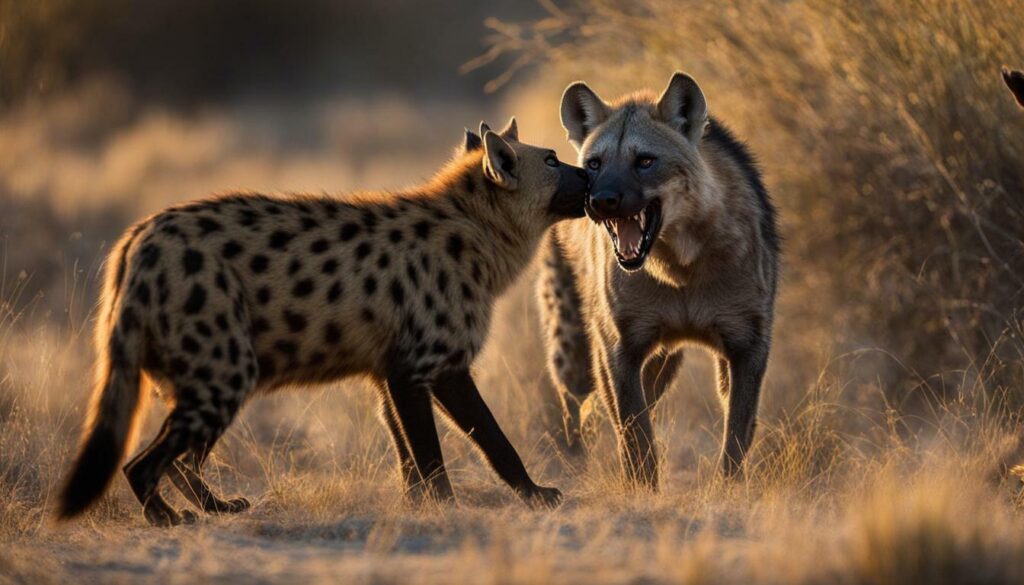
The rivalry between these two creatures is further exemplified when observing their interactions with other predators. For example, hyenas have been known to steal kills from lions, showcasing their opportunistic nature. While a single hyena may not stand a chance against a lion in a one-on-one battle, their pack mentality and powerful bite can make them a formidable opponent. Conversely, wildcats like leopards are known for their ability to hunt and kill prey on their own, showcasing their independence and stealthy hunting techniques.
Comparing the Hunting Styles
| Hyenas | Wildcats |
|---|---|
| Prefer pack hunting | Hunt alone |
| Overwhelm prey with numbers | Reliance on speed and agility |
| Use powerful bite force | Stealthy and cunning hunting techniques |
While a face-off between a wildcat and hyena may be unlikely, it is fascinating to explore the unique characteristics and hunting strategies of these two creatures. Nature continuously reveals its wonders through such encounters, demonstrating the diverse tactics animals employ to survive in the wild.
Hyenas: Predator or Scavenger?
Hyenas have a reputation as both predators and scavengers, with the ability to kill prey and scavenge on carrion. They are known for their opportunistic nature, making the most of any available food source. Whether it’s taking down their own prey or feasting on the remains of a fresh kill, hyenas are adaptable and efficient hunters.
According to eyewitness accounts from South Africa’s Sabi Sands Game Reserve, hyenas are also known to scavenge from other predators, such as lions. Often, when a lioness makes a kill, hyenas are thought to wait their turn, patiently scavenging for whatever is left. This behavior highlights the resourcefulness of hyenas, as they make the most of any opportunity to satisfy their hunger.
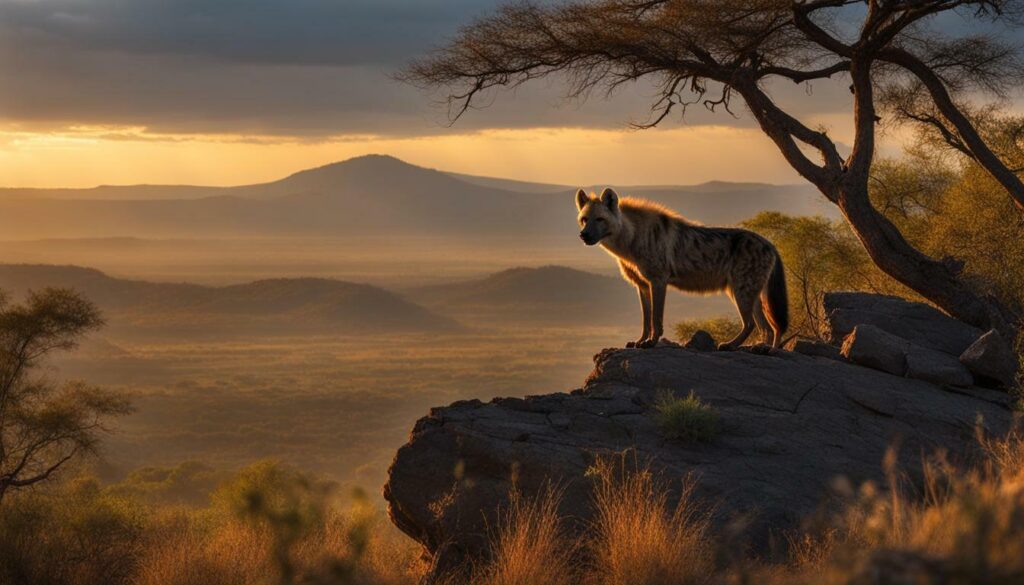
Although hyenas are primarily scavengers, they are more than capable of killing their own prey. In certain circumstances, such as when they hunt in packs, hyenas can overpower larger animals like warthogs, wildebeests, and even elephants. This illustrates their strength and tenacity as predators, as they work together to bring down their chosen prey.
In conclusion, hyenas are versatile creatures that play an important role in the ecosystem. They are opportunistic scavengers, making the most of any available food source, while also displaying the ability to hunt and kill their own prey. Their adaptability and resourcefulness make them a force to be reckoned with in the wilderness.
Leopards: The Stealthy Hunters
Leopards, known for their stealth and hunting prowess, are masterful ambush predators that often hunt alone. These majestic felidae utilize their keen senses and incredible agility to silently stalk their prey, waiting for the perfect moment to strike. With their well-camouflaged coats and remarkable ability to blend into their surroundings, leopards are virtually invisible as they patiently lie in wait.
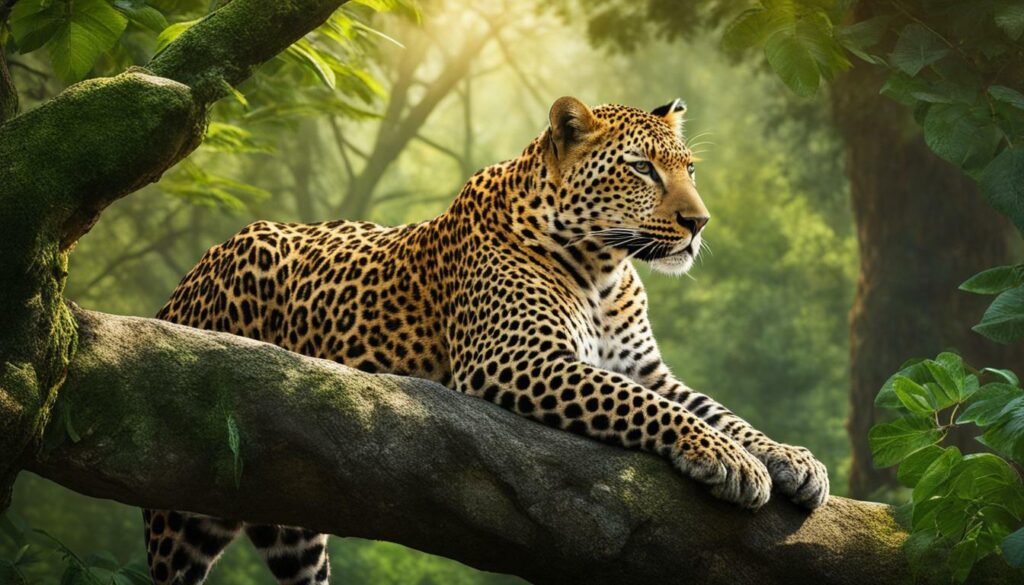
Once their unsuspecting prey, which primarily consists of ungulates such as gazelles and impalas, comes within striking distance, leopards unleash their impressive speed and strength, springing forth from their concealed positions with unmatched precision. The element of surprise is their greatest weapon, allowing them to take down prey several times their size.
Leopards, as solitary predators, rely on their remarkable hunting skills to provide for themselves. Their ability to successfully execute ambush attacks stems from years of practice and their inherent predatory instincts. In the wild, leopards have perfected their craft, becoming the epitome of stealth and agility.
Analyzing Bite Power: Hyenas vs Wildcats
When it comes to bite power, both hyenas and wildcats, including the striped hyena, possess powerful jaws and a significant bite force. These formidable predators rely on their exceptional bite strength to subdue and kill their prey.
Hyenas, known for their scavenging abilities, have been observed in astonishing displays of power when they engage in confrontations with other animals. They can deliver a bone-crushing bite, making them a force to be reckoned with in the animal kingdom.
Similarly, wildcats, such as the leopard and other species mentioned earlier, are skilled hunters with strong jaws capable of delivering a lethal bite to their prey. These solitary predators rely on their agility and speed to overpower their victims, adding to the impact of their powerful bite.
While their bite power may be comparable, it is essential to recognize that hyenas and wildcats have distinct hunting strategies and behaviors. Hyenas are known for their pack hunting nature, using their strength in numbers to bring down larger prey. On the other hand, wildcats rely on their individual hunting prowess, often taking down their prey on their own.

Habitat and Behavior: Hyenas and Wildcats
Hyenas and wildcats are found in a variety of habitats, including woodlands, savannahs, grasslands, and forest edges. These diverse environments provide them with ample opportunities to thrive and showcase their unique behaviors.
Hyenas, known for their strong social structures, often reside in open woodlands and grasslands. They are highly adaptable and can be found across sub-Saharan Africa, making use of geographic channels such as savannahs and forest edges. With their carnivorous nature and powerful bite, hyenas play a crucial role as both predators and scavengers in the animal kingdom.
On the other hand, wildcats, closely related to domestic cats, exhibit a solitary lifestyle. They are typically found in a range of habitats, including woodlands, savannahs, and grasslands, where they utilize their agility to hunt and survive. With species like the leopard, panther, lynx, and others, wildcats are skilled predators that rely on their solitary hunting techniques to secure their prey.

Although hyenas and wildcats have distinct behaviors, they share the common trait of being carnivorous mammals. Their habitats, prey preferences, and hunting strategies may differ, but they both occupy important roles as apex predators in their respective ecosystems. The diversity of their behaviors and habitats adds to the fascinating wonders of nature.
By understanding the intricacies of hyenas and wildcats, we can gain a deeper appreciation for the complexity of the natural world. Their coexistence in environments such as woodlands, savannahs, and grasslands highlights the delicate balance of predator and prey dynamics. Through their distinct behaviors and habitat preferences, hyenas and wildcats contribute to the rich tapestry of wildlife found in the wild.
Hyenas and Wildcats: Role as Apex Predators
Both hyenas and wildcats, such as leopards and lionesses, play important roles as apex predators in their respective ecosystems. These majestic creatures, with their powerful jaws and predatory instincts, shape the delicate balance of nature in their habitats.
Hyenas, known for their scavenging abilities, also possess impressive hunting skills. They are opportunistic predators that take down prey as diverse as wildebeests, warthogs, and even young elephants. With their exceptional endurance and pack-hunting tactics, hyenas can overpower larger prey and fend off competing predators.
On the other hand, wildcats like leopards and lionesses are solitary hunters, relying on their stealth and agility to stalk and ambush their targets. With their impeccable camouflage and lightning-fast reflexes, these feline predators are capable of taking down a variety of prey, from small mammals to large ungulates.
As apex predators, hyenas and wildcats exert their influence on their ecosystems, regulating the population of herbivores and maintaining the delicate balance of nature. Their presence ensures the overall health and sustainability of the wild habitats they call home.
Table: A Quick Comparison of Hyenas and Wildcats
| Hyenas | Wildcats |
|---|---|
| Scavengers with powerful bite force | Stealthy hunters with tremendous agility |
| Pack hunters, capable of taking down larger prey | Solitary hunters, relying on stealth and ambush |
| Opportunistic predators, feeding on carrion and stolen kills | Predators with a wide range of preferred prey |
| Known for their distinctive vocalizations and social hierarchy | Characterized by their solitary nature and territorial behavior |
While each has its unique hunting strategies and characteristics, both hyenas and wildcats are vital components of their ecosystems, continuously shaping the intricate web of life in the wilderness. Their presence adds an element of awe and wonder to the natural world, reminding us of the fascinating power and diversity of nature’s creations.
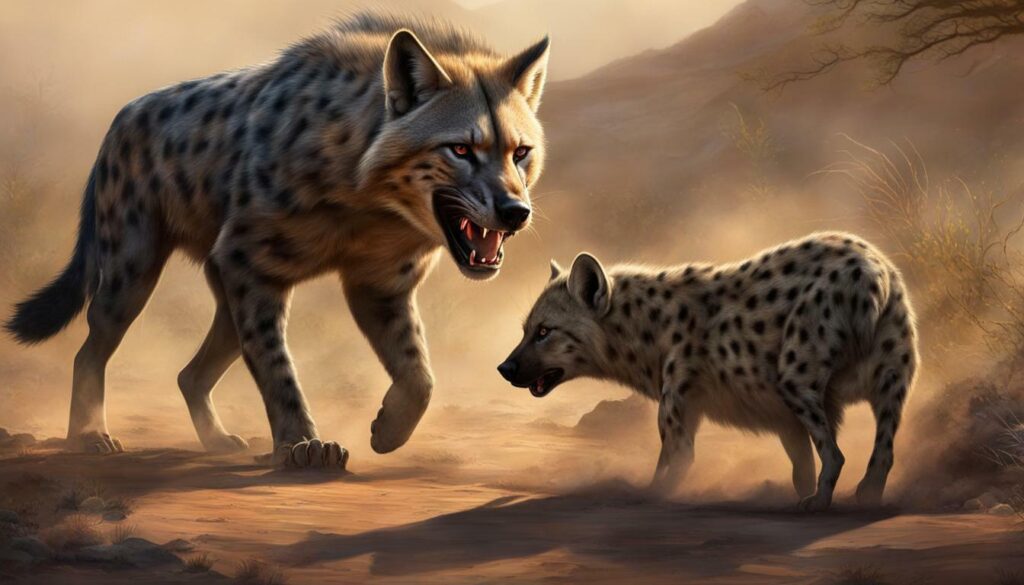
Interactions between hyenas, wild dogs, and their prey are fascinating, with hyenas sometimes stealing kills from lions and playing a significant role as important predators. In the wild, these apex predators navigate a complex web of competition and survival. A recent incident in South Africa’s Sabi Sands Game Reserve showcased an intriguing encounter between hyenas and wild dogs, shedding light on their dynamic relationship.
During the encounter, which lasted over 30 minutes, tensions ran high as the two predator species squared off. Wild dogs, known for their playful nature, seemed carefree and unbothered, while the hyenas appeared nervous, exhibiting signs of submission. This interaction was likely a territorial tiff, with both species asserting their dominance and vying for resources.
Witnessing such interactions in the wild offers a glimpse into the delicate balance of nature, where each species has a role to play in sustaining the ecosystem.
Hyenas and wild dogs are both skilled predators, but their hunting strategies and social structures differ. While hyenas typically hunt in packs, using teamwork to take down large prey, wild dogs prefer to hunt in smaller groups, relying on their speed and endurance. This difference in hunting behavior may explain the occasional theft of kills by hyenas, as they take advantage of the scattered nature of wild dog packs.
These interactions highlight the complexities and dynamics of predator-prey relationships in the natural world. Understanding the balance between these important predators is crucial in conserving biodiversity and preserving the delicate ecosystems they inhabit.

| Hyenas | Wild Dogs |
|---|---|
| Known for scavenging and stealing kills from other predators. | Hunt smaller prey cooperatively, relying on speed and endurance. |
| Have a hierarchical society with an alpha female leading the clan. | Live in social packs with a complex hierarchy led by an alpha pair. |
| Powerful bite force allows them to crush and consume bone marrow. | Exceptional stamina enables them to pursue prey over long distances. |
The Ultimate Face-Off: Myth or Reality?
The ultimate face-off between a wildcat and a hyena is an intriguing concept, but in reality, these encounters are rare due to the tendency for hyenas to outnumber their opponents. While both wildcats and hyenas are formidable predators in their own right, their behaviors and hunting strategies often determine the outcome of any potential clash. Let’s take a closer look at how a one-on-one battle between a wildcat and a hyena might play out in different scenarios.
When it comes to encounters with larger prey such as warthogs, wildebeests, and elephants, hyenas typically have the advantage due to their pack hunting nature. A single hyena would struggle to overpower these massive animals on its own. On the other hand, wildcats, like the fierce leopard, rely on their speed, agility, and stealth to hunt. They often prefer to target smaller prey, using their solitary hunting habits to their advantage.
It is important to note that both hyenas and wildcats possess ferocious hunting abilities and powerful jaws. However, the odds are stacked against the wildcat in a direct confrontation with a hyena, given the hyenas’ numerical advantage. While a wildcat might put up a valiant fight, it would be unlikely to emerge victorious in such an encounter.

Ultimately, the ultimate face-off between a wildcat and a hyena remains more of a myth than a reality. Nature has intricately designed these animals with unique hunting strategies and adaptations, allowing them to thrive in their respective environments. As we continue to explore the wonders of the animal kingdom, it is crucial to appreciate the complex dynamics and diverse relationships that exist, each playing a vital role in maintaining the delicate balance of our wilderness.
Uncovering the Similarities and Differences
Uncovering the similarities and differences between hyenas and wildcats reveals fascinating aspects of their taxonomy and key characteristics as felids and canids. While both hyenas and wildcats exist within the broader feline family, they belong to different subfamilies: hyenas are part of the Hyaenidae family, while wildcats fall under the Felidae family. Although they share some physiological features, such as sharp teeth and claws, their behaviors and lifestyles diverge significantly.
Hyenas, closely related to cats, have a unique social structure and thrive in group settings. They are known for their distinctive laughter-like vocalizations and have a reputation as both predators and scavengers. On the other hand, wildcats, including species like leopards, panthers, and lynxes, are solitary hunters and have adapted to various habitats worldwide. Their hunting techniques often involve stealth and agility, making them formidable predators.
The differences between these two carnivorous mammals extend beyond their social structures and hunting behaviors. Hyenas typically have a more robust build compared to wildcats, with powerful jaws capable of crushing large bones. In contrast, wildcats rely on speed and precision to capture their prey. Additionally, hyenas have been known to scavenge and steal kills from other predators, while wildcats prefer to hunt and consume their meals alone.
| Hyenas | Wildcats |
|---|---|
| Belong to the Hyaenidae family | Belong to the Felidae family |
| Known for their social structure and group living | Primarily solitary hunters |
| Have a robust build and powerful jaws | Rely on speed and agility |
| Display scavenging tendencies and often steal kills | Prefer to hunt and consume meals alone |
“While hyenas and wildcats belong to different families within the feline order, they do share common attributes. However, their behaviors and hunting strategies set them apart, making each species unique in its own right.”
Unraveling the taxonomy and contrasting characteristics of hyenas and wildcats provides an insightful glimpse into the diversity of the animal kingdom. These fascinating creatures, closely related to cats and canids, each possess their own set of traits and behaviors. Exploring their distinct features enriches our understanding of the natural world and the intricate web of life.
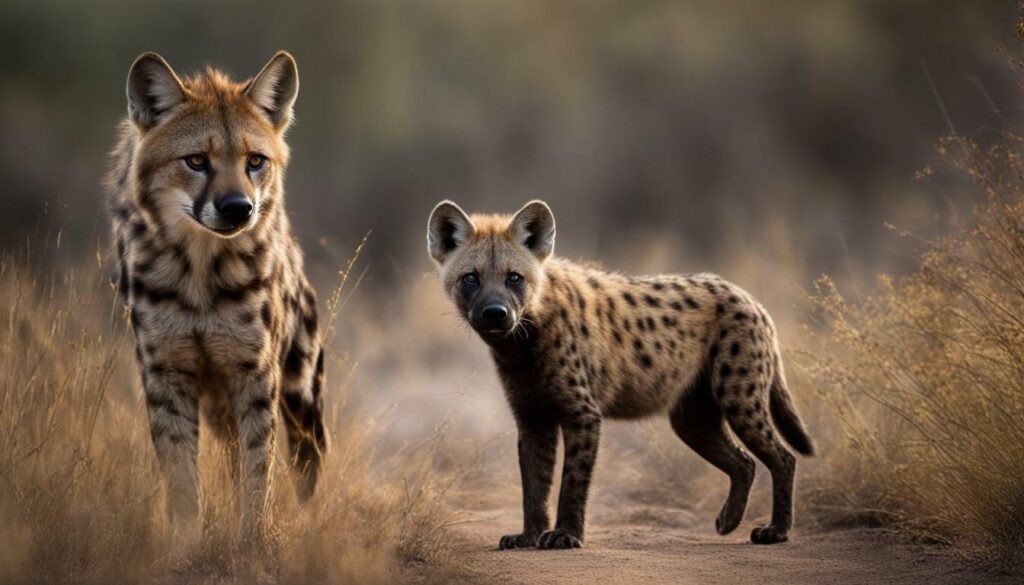
- Hyenas and wildcats share similarities as carnivorous mammals.
- Hyenas belong to the Hyaenidae family, while wildcats fall under the Felidae family.
- Hyenas exhibit a social structure and are often found in groups, while wildcats are solitary hunters.
- Hyenas possess a robust build and powerful jaws, while wildcats rely on speed and agility.
- Hyenas scavenge and steal kills, whereas wildcats prefer to hunt alone.
Conclusion: Appreciating Nature’s Wonders
Appreciating the wonders of nature involves understanding the intricate dynamics between hyenas, wildcats, and other carnivorous mammals that play important roles as predators, scavengers, and prey in the wild. Witnessing the fascinating face-off between these creatures reminds us of the complexity and beauty of the natural world.
Hyenas, known for their powerful bite and scavenging abilities, demonstrate their prowess as both predators and opportunistic feeders. Their interactions with wild dogs, as witnessed in South Africa’s Sabi Sands Game Reserve, provide valuable insights into their territorial nature and the dynamic relationships within their social hierarchies. While the wild dogs showcased their carefree and playful behavior, the hyenas displayed a more nervous disposition, possibly indicating a sense of submission.
While the specific details of a face-off between wildcats and hyenas remain elusive, the swift and agile nature of wildcats, combined with their solitary hunting habits, often make them more successful in encounters. Wildcats, including species like leopards, panthers, and lynx, epitomize the stealth and prowess of apex predators in the wild. Their ability to ambush prey and hunt alone showcases their natural effectiveness as hunters.
As we delve into the similarities and differences between these remarkable creatures, we gain a deeper appreciation for their role in balancing ecosystems. Hyenas and wildcats, with their distinct hunting strategies and unique adaptations, contribute to the intricate web of life that shapes our world. So, let us marvel at nature’s wonders and strive to protect the delicate balance that exists between predators, scavengers, and prey.
FAQ
What is the wildcat vs hyena face-off all about?
The wildcat vs hyena face-off refers to the intriguing interaction between these two formidable creatures in the wilderness. It’s a contest that explores nature’s secrets and showcases the unique dynamics between different apex predators.
How do hyenas and wildcats compare as predators?
Hyenas and wildcats are both apex predators, but they exhibit different hunting strategies. Hyenas are known for their pack hunting nature, while wildcats prefer to hunt alone. They have different methods of predation, but both are highly skilled hunters in their own right.
Are hyenas more successful than wildcats in encounters?
While hyenas are known for their powerful bite and ability to overpower larger predators, wildcats, with their speed and agility, are generally considered more successful in encounters. Their solitary hunting habits and quick reflexes give them an advantage in taking down prey.
Do hyenas scavenge or are they purely predators?
Hyenas are versatile creatures that exhibit both predatory and scavenging behavior. While they are skilled hunters, they are also known to scavenge on carrion. Their opportunistic nature allows them to make use of available food resources in their environment.
How do wildcats, like leopards, compare to hyenas in terms of hunting techniques?
Wildcats, such as leopards, are stealthy hunters that rely on ambush tactics to catch their prey. They prefer a solitary approach and tend to target smaller ungulates. Hyenas, on the other hand, often hunt in packs and are known for their persistence in taking down larger prey.
Who would win in a direct face-off between a wildcat and a hyena?
While it’s difficult to predict the outcome of a one-on-one battle between a wildcat and a hyena, it’s important to note that hyenas often outnumber a single hyena. In most cases, a direct confrontation between the two is unlikely to occur due to the differences in their hunting strategies and the hyenas’ pack-mentality.
What are the main similarities and differences between hyenas and wildcats?
Hyenas and wildcats are both carnivorous mammals and belong to different families. Hyenas are more closely related to canids, while wildcats are classified as felids. Despite their differences, they both hold important roles as apex predators in the animal kingdom.
How do hyenas and wildcats contribute to the ecosystem as apex predators?
Hyenas and wildcats play vital roles as apex predators in the ecosystem. They help control populations of other animals, ensuring a balance in the food chain. Their predatory activities contribute to the overall health and stability of the ecosystem.
Can hyenas steal kills from other predators?
Yes, hyenas are known to scavenge and can steal kills from other predators, including lions. They have a powerful bite and are not afraid to challenge other carnivores for food resources. This behavior further emphasizes their role as versatile scavengers in the wilderness.
What should we appreciate about the interaction between hyenas, wildcats, and other animals in the wilderness?
The interaction between hyenas, wildcats, and other animals in the wilderness highlights the intricate dynamics of the natural world. It showcases the diversity of behaviors, roles, and relationships that exist in the animal kingdom. By appreciating these wonders, we can gain a deeper understanding and respect for nature.

